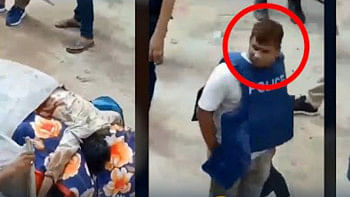Kala Azar reappears in full fury in Mymensingh

A doctor taking blood sample of a child at Phulbaria Upazila Health Complex for Kala Azar test.Photo: STAR
Killer disease Kala Azar has reappeared in bordering hilly areas of the district.
It claimed 11 lives in four upazilas of Mymensingh in last nine months. Seven of the deaths were reported from Trishal upazila, two in Phulbaria and one each in Haluaghat and Bhaluka upazilas.
Over 2000 people were infected with Kala Azar this year till last month, official sources said. Of them, 1807 were treated at different health complexes.
Among the infected people, some 900 were in Trishal, 840 in Phulbaria, 131 in Bhaluka, 110 in Gafargoan, 14 in Haluaghat while 11 in Nandail Upazila.
It killed 10 people including four in Phulbaria last year. In the same year, the disease infected 4193 people including 2030 in Phulbaria.
A total of 3726 patients were treated for the disease at different health complexes last year.
Phulbaria upazila topped the list for Kala Azar attacks.
Doctors said as most of the houses in remote areas of Phulbaria are mud-built, female sand flies easily transmit the vector-borne disease to humans.
Attack by the disease can not be stopped due to lack of awareness and proper preventive steps, doctors said.
It is also alleged in some health complexes, arrangements for blood test is not available that hampers treatment of Kala Azar patients.
Last month (September) some 100 people were infected with Kala Azar in Phulbaria upazila. Most of the patients were from Chowder, Kaladah, Radhakanai, Nichhintapur, Kushmile, Ramnagar, Phultala, Kayerchala, Naugoan, Palashtali and Putigana villages.
Kala Azar patients are also affected with Post Kala Azar Dermal Leismeniasis (PKDL) if they are not fully cured, the doctors said. A Kala Azar patient has to take treatment for 21 to 28 days and in many cases patients, mainly poor ones, do not complete the course and are eventually affected with PKDL, they said. After being attacked with PKDL, a patient has to undergo treatment for 120 days, they said.
Talking to the Daily Star, Mymensingh Civil Surgeon Dr. SM Shamsul Alam said spread of the disease can not be checked unless preventive measured are strengthened.
He said a campaign should be launched to create awareness among people about the disease.
He said medicines are available at local health complexes but patients have to go there for injections for 21 to 28 days.
As the treatment starts, a patient feels better and do not complete their full course. They fall victims to PKDL, he said.
Direct Agglutination Test (DAT) to diagnose Kala Azar and Aldehyte Test (AT) for primary investigation are available at health complexes, he added.
He however claimed that the situation is under full control.
The medicine for the disease is beyond the reach of the poor. Stibatin injection, the only medicine for its treatment, is sold at between Tk 150 and TK 200 against its actual price of Tk 110. Often there is crisis of the injection, the civil surgeon said.
Malaria
However, no death from Malaria was reported in Mymensingh this year and from many areas, the disease has been eradicated, claimed a source at the civil surgeon's Office.
According to sources, a total of 8131 patients were tested from January to August this year and only 66 were found positive including 48 in Dhubaura, 13 in Haluaghat, three in Phulpur while one each in Gouripur, Bhaluka and Nandail Upazilas.

 For all latest news, follow The Daily Star's Google News channel.
For all latest news, follow The Daily Star's Google News channel. 




Comments